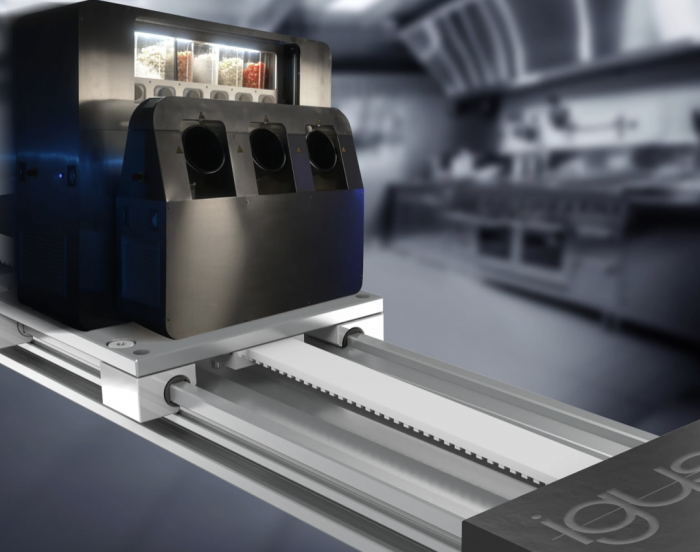Automation in the catering industry with igus: Space miracle for confined spaces

It conjures up fresh and healthy dishes without human assistance and is intended to relieve restaurateurs of the pressure of the shortage of skilled workers: the robot kitchen from the French company Cook-e. The developers rely on compact and hygienic toothed belt axles from igus so that the electromechanical cooking artist can also swing the pots in restaurants with little space.
Working hours late into the night, non-stop stress, even at weekends: the job of a chef is not very attractive for many young people. Accordingly, restaurateurs are tense about the future. Will the kitchen eventually remain cold? No, Cook-e is convinced. The French company has found a way to relieve restaurants in times of a shortage of skilled workers. Without further ado, a robot kitchen takes over the hard work. But how do you cook without any staff? The guest or the service staff place the order via tablet, input terminal or app. And the kitchen starts preparing an individual dish fully automatically. Step one: assemble the ingredients according to recipes stored in the software. For this, dosing containers move along a shelf with storage modules. Depending on the menu selected, rice, shredded chicken, corn and other chopped ingredients are taken out with an accuracy of 0.5 grams. Once all the ingredients have been collected, the contents are poured into one of three rotating cooking modules that resemble a wok pan. They can rotate and tilt, mix, fry and stir. Just 210 seconds after ordering, the dish is then ready to serve. According to Cook-e, this makes 250 dishes per hour possible, such as delicious risottos, chilli con carne or osso bucco. Quentin Guilleus, co-founder of the company, is convinced that there is a great future for this type of gastronomy: “The automation of simple tasks and the associated, lower costs allow restaurant owners to invest more in ingredients and service quality to offer a better restaurant experience with consistently high-quality dishes.”
drylin ZLW: Because space in kitchens is worth its weight in gold
To ensure that as many restaurants as possible can benefit from automation, Cook-e has designed the robotic kitchen to save as much space as possible. This is because rental prices are high and kitchens are correspondingly small, especially in global metropolises. All components are therefore compact – from the storage modules for the ingredients to the mechanics for positioning the dosing container. Here, the engineers initially considered using a linear guide with ball-bearing slides. However, this solution would have taken up too much space. The experts therefore decided on an alternative: electric toothed belt axes from igus. “The toothed belt axes of the drylin ZLW series are the ideal solution for light adjustment and positioning tasks in restricted spaces, where every millimetre counts,” says Michael Hornung, igus product manager for drylin linear and drive technology. The installation height is only 31 mm. “The igus solution enables a more compact design, which reduces the volume of our machines,” confirms Guilleus. As an installation area, the robot kitchen requires only 2.7 square metres.
Lubrication-free polymer bushings ensure hygiene
But the components of the robotic kitchen should not only be compact, they should also meet the high hygienic requirements of HACCP – a hygiene concept originally developed by NASA to ensure food safety for astronauts. Guilleus: “The materials chosen, mainly stainless steel and PETG, are suitable for contact with food.” The toothed belt axles fit in seamlessly here, as igus manufactures the cross beams and linear carriages from corrosion-resistant stainless steel. The carriages move on them on linear plain bearings made of high-performance plastic. The highlight: The plain bearings require no lubrication and are thus completely maintenance-free. By dispensing with external grease and lubricants, all bearing points and surfaces are hygienic and clean, and are also extremely easy to clean and quickly ready for operation again. This is important because the kitchen cleans itself automatically after every meal prepared. To do this, the dosing container and pan tilt down. A high-pressure water jet with cleaning agents takes over the cleaning.
For more information, please visit: https://www.igus.de
News Categories
- » NEWS HOME
- » Automation & Robotics
- » Industry 4.0
- » Material Handling
- » Sensors
- » Quality & Testing
- » Machine Vision
- » Laser & Optics
- » Metalworking
- » Motion Control & Drives
- » Hydraulics & Pneumatics
- » Process Industry
- » Renewable Energy
- » Agriculture
- » Home & Office Furniture
- » Environmental Tech




